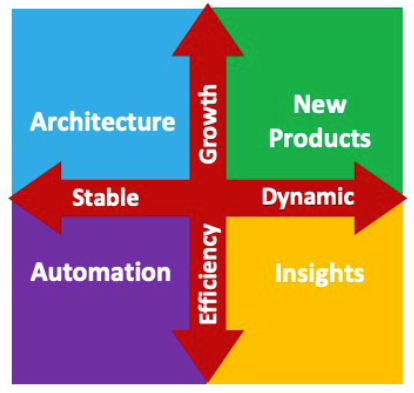Getting Started with Artificial Intelligence: A Primer for Business Organizations
Published: Jul 12, 2024

By AMA Staff
Business organizations across the globe are racing to embrace AI and capitalize on the competitive advantages it can deliver. Yet a recent American Management Association survey found that only a small fraction of respondents, about 17%, said their organization has an AI strategy. Many in the remaining 83% are likely wondering, What’s in it for us? How do we get started? How do we prepare to take the giant leap into the future that AI promises?
While there is no standard playbook, the experts at the American Management Association have devised a matrix to help organizations (and their? functions, departments, or teams) define their business context and identify how AI can help. The matrix divides organizations into four quadrants, as shown below.

The y-axis represents the organization’s overarching business goals. Does it primarily target growth or efficiency? A profit center would likely focus on growth, while a back-office function would prioritize efficiency. The x-axis pinpoints whether operating conditions are stable or dynamic. Below, we unpack how organizations in each quadrant can benefit from AI.
Stable/Efficiency → Automation
Operations, finance and IT are examples of business functions that seek efficiency and operate under stable business conditions. This category may also include software and tool vendors. The business functions in this quadrant can get the most out of AI by focusing on automation.
AI-driven automation can dramatically expedite routine or repetitive processes, reducing costs and liberating staff to do higher-value work. In many cases, AI can also improve accuracy and consistency, and can assist with advanced data analysis. For instance, the finance function could automate accounts receivable using AI tools that extract data from invoices, match it with purchase orders, and process payments after approval.
Key activities for business functions? in the stable/efficiency quadrant include evaluating and selecting AI tools, updating processes, assessing quality, configuring tools and dealing with regressions.
Dynamic/Growth → New Products
Product, customer-value and similar teams target growth and operate under dynamic business conditions. AI holds great promise in helping these teams create and sell new features, products, and services that were not feasible without AI. For instance, in recent decades, tech companies have used AI to power maps (Google or Apple Maps) and photo features (image search and album creation in Google or Apple photo apps).
Key activities for these teams include identifying unmet user needs, designing AI that can field tasks, and developing user experiences that seamlessly incorporate AI. These teams will also need to market these new features, promote user adoption, and update business models to ensure profitability.
Dynamic/Efficiency → Insights
Data scientists and analysts occupy the quadrant in our matrix that focuses on efficiency in a dynamic context. These functions use AI to improve the quality and quantity of the organization’s novel decisions. Examples include business intelligence and interactive predictive models. For instance, an AI-driven predictive model can estimate a customer’s lifetime value based on a complex range of inputs, such as purchase history, customer interactions, and response to past marketing campaigns.
Key activities for data teams include organizing data, creating databases, integrating new data and developing visualizations, APIs and user experiences.
Stable/Growth → Architecture
Finally, growth in a stable context is the purview of systems architects and database and data center engineers. Their goal is to create systems that support the company’s customers?, processes and growth, such as proprietary models trained on company data that create outputs for customers. For instance, a systems architect at a telecom company could use AI to create a model that analyzes each customer’s data usage and develops a personalized data plan optimized for the customer’s cost efficiency.
To capitalize on such opportunities, these teams need to differentiate priority and commodity needs; design and develop proprietary systems; onboard and support users; maintain and refine systems; and prepare for future states.
Conclusion
It’s important to recognize that each business organization’s, as well as each team’s?, adoption journey will be different, and will depend on the business context and goals. As our matrix implies, even within a company, different teams will need to determine for themselves how AI can best serve their needs. A one-size-fits-all approach is bound to backfire. Strategies that are appropriate for a team focused on optimization will create friction and fail to deliver value if applied to teams focused on R&D.
To learn more about how AI can help your organization, consider enrolling in AMA’s Artificial Intelligence (AI) Business Essentials Certificate Program.
About AMA
American Management Association (AMA) is globally recognized as a leader in professional development. For nearly 100 years, it has helped millions of people bring about positive change in their performance in order to improve results. AMA’s learn-by-doing instructor-led methods, extensive content, and flexible learning formats are proven effective—and constantly evolve to meet the changing needs of individuals and organizations. To learn more, visit www.amanet.org